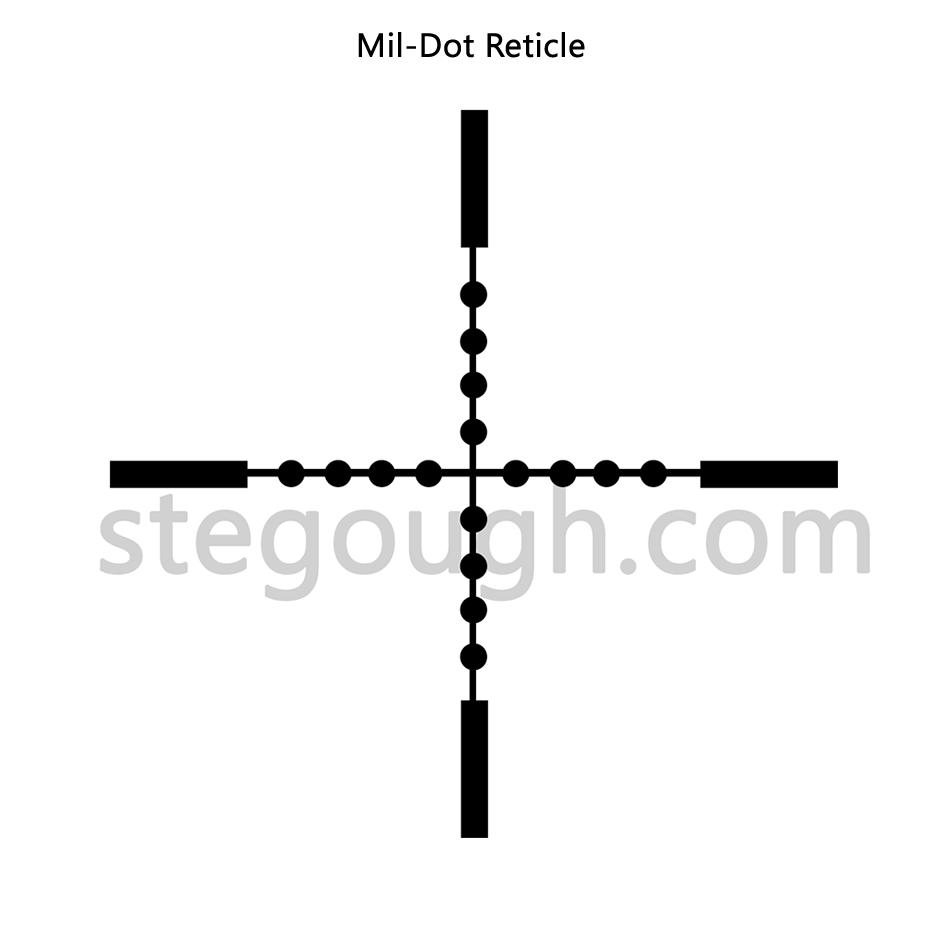Following on from Understanding Mils, I’m going to try and put that information into the context of Mil-Dot Scope Reticles.
Since a Mil is a unit of angular measurement, and in this case not short for ‘Military’ as people often assume, it would be safe to assume that a ‘Mil-Dot’ Reticle has something to do with angular measurement too.
As a re-iteration, 1 Mil is 1000th measure of the distance. For more info read Understanding Milliradians (Mil, Mil-Rad).
The Mil-Dot Reticle
So a Mil-Dot reticle is precisely laid out to give known angles at a glance. When you know the representative angles as shown above and what those markings mean at your target distance, it becomes easier to use these for corrections.
For example, if you put a shot on target and it ends up 1 Mil high and 2 Mils Left, you could see the shot placement on your sight and know that you need to adjust 1 Mil down and 2 Mils right with your click correction, OR if time is of the essence you could aim off using the dots and shoot 2 dots right and 1 dot below. Like this:
So for speed and efficiency, Mil-Dot helps us correct shots that have gone off accurately since we have an accurate scale which we can judge shots.
But that’s not all Mil-Dot can help with.
Mil-Dot Reticle Range Estimation In Yards
Since we know the size in Mils of the various gaps or dots of our sight, and we worked out that the Distance (R) is relative to the target size (1000 x) we can use this information to estimate the distance to target.
Say we have a target that’s a known height. A car wheel for instance, that we know is 15″ in diameter. We can hold the sights over the car wheel and use the size of the object in the sights to gauge the angle it is.
This gives us 2 pieces of information, from which we can extrapolate the third. 15″ wheel (Tz – Target Size) is 5 Mils (M – Mils) at our Distance (R). So how do we get the distance?
Since we’re working in Millirads, and we want to find the Radius, we need to start by multiplying our Target size by 1000 which will give us the total of 5 radians at this distance. But we only want to know the distance of 1 so we divide that total by the number of Mils we read.
(Tz * 1000) / 5 = Distance to Target
We would be 3000″ from our target in this scenario. That doesn’t help us much so we need to convert that total into Yards (Or Metres, depending on the unit of measure you are working in.
There are 36″ in a yard, so we would divide 3000 / 36.
83.3333 Recurring Yards.
The Target in this scenario is pretty close.
What about Mil-Dot Reticle Estimation in Metres
It works in exactly the same way as I outlined above, perhaps to make things easier if we estimate the size of our target in a metric system rather than that of ye olde time imperial, it might make things a little clearer.
I’ll make a new picture and work this one out in Metric.
This time the wheel is either really small, or really far away, and since we know the size of the wheel is 15″ 38 cm (+/- .1cm) we can estimate the range using exactly the same formula as above.
(Tz * 1000) / M = Distance to Target
(38*1000) / 1.5 = 25333.3cm
Convert that to metres – and herein lies the beauty of the metric system, divide by 100 (Or simply move the decimal point over to the left by 2)
253.3 Metres to target.
It’s pretty darn simple when you use Mils with Metres.
Why did I Estimate Mil-Dot Range with Yards
Well, whilst it is simple to use Mil-Dot buy ambien drug with Mils, and it makes sense, you don’t only find Mil-Dot reticles on Mil-Click scopes. Infact I have 2 MOA-Click scopes with Mil-Dot reticles. Though I only use them for static shooting at known distances the range estimation features are useless, to me, for now. However being able to use the Mil-Dot as a reference point for Hold-Over correction is worth having it in itself, and well, it looks cool, It’s the kind of scope you see on video games and movies, and it’s pretty cool. But now you know how it works, it’s also practical as well as being cool!
When would using Mil-Dot Range Estimation Be Useful?
For Civilians, it would be useful for field target competitions, where you need to estimate the distance to the target in order to score a first round hit. if you know the target is 12 ” you can use the mil-dot to work out the distance and dial in the zero for that distance for a perfect first round hit. Likewise for hunting, where range estimation is everything when taking a shot on live quarry. You don’t always get a chance for a second.
For Military it is invaluable to be able to judge how far away the enemy is quickly. Often soldiers will carry charts of known sized targets at different ranges with their Mil Dot size to range distance. A lot of the time they won’t need it because they train and work with the system so much it becomes second nature, which is the same for hunters, who will often use the dots to aim off to get that quick shot without being seen or heard.
Imperial Mil-Dot Table
Object Size 12" 24" 1Yds 48" 60" 2Yds 84" 96" 3Yds 0.5 Mils 667Yds 1333Yds 2000Yds 2667Yds 3333Yds 4000Yds 4667Yds 5333Yds 6000Yds 1 Mils 333Yds 667Yds 1000Yds 1333Yds 1667Yds 2000Yds 2333Yds 2667Yds 3000Yds 1.5 Mils 222Yds 444Yds 667Yds 889Yds 1111Yds 1333Yds 1556Yds 1778Yds 2000Yds 2 Mils 167Yds 333Yds 500Yds 667Yds 833Yds 1000Yds 1167Yds 1333Yds 1500Yds 2.5 Mils 133Yds 267Yds 400Yds 533Yds 667Yds 800Yds 933Yds 1067Yds 1200Yds 3 Mils 111Yds 222Yds 333Yds 444Yds 556Yds 667Yds 778Yds 889Yds 1000Yds 3.5 Mils 95Yds 190Yds 286Yds 381Yds 476Yds 571Yds 667Yds 762Yds 857Yds 4 Mils 83Yds 167Yds 250Yds 333Yds 417Yds 500Yds 583Yds 667Yds 750Yds 4.5 Mils 74Yds 148Yds 222Yds 296Yds 370Yds 444Yds 519Yds 593Yds 667Yds 5 Mils 67Yds 133Yds 200Yds 267Yds 333Yds 400Yds 467Yds 533Yds 600Yds 5.5 Mils 61Yds 121Yds 182Yds 242Yds 303Yds 364Yds 424Yds 485Yds 545Yds 6 Mils 56Yds 111Yds 167Yds 222Yds 278Yds 333Yds 389Yds 444Yds 500Yds 6.5 Mils 51Yds 103Yds 154Yds 205Yds 256Yds 308Yds 359Yds 410Yds 462Yds 7 Mils 48Yds 95Yds 143Yds 190Yds 238Yds 286Yds 333Yds 381Yds 429Yds 7.5 Mils 44Yds 89Yds 133Yds 178Yds 222Yds 267Yds 311Yds 356Yds 400Yds 8 Mils 42Yds 83Yds 125Yds 167Yds 208Yds 250Yds 292Yds 333Yds 375Yds 8.5 Mils 39Yds 78Yds 118Yds 157Yds 196Yds 235Yds 275Yds 314Yds 353Yds 9 Mils 37Yds 74Yds 111Yds 148Yds 185Yds 222Yds 259Yds 296Yds 333Yds 9.5 Mils 35Yds 70Yds 105Yds 140Yds 175Yds 211Yds 246Yds 281Yds 316Yds 10 Mils 33Yds 67Yds 100Yds 133Yds 167Yds 200Yds 233Yds 267Yds 300Yds
Metric Mil-Dot Table
Object Size 25cm 50cm 75cm 1m 1.25m 1.5m 1.75m 2m 2.25m 2.5m 2.75m 3m 0.5 Mils 500m 1000m 1500m 2000m 2500m 3000m 3500m 4000m 4500m 5000m 5500m 6000m 1 Mils 250m 500m 750m 1000m 1250m 1500m 1750m 2000m 2250m 2500m 2750m 3000m 1.5 Mils 167m 333m 500m 667m 833m 1000m 1167m 1333m 1500m 1667m 1833m 2000m 2 Mils 125m 250m 375m 500m 625m 750m 875m 1000m 1125m 1250m 1375m 1500m 2.5 Mils 100m 200m 300m 400m 500m 600m 700m 800m 900m 1000m 1100m 1200m 3 Mils 83m 167m 250m 333m 417m 500m 583m 667m 750m 833m 917m 1000m 3.5 Mils 71m 143m 214m 286m 357m 429m 500m 571m 643m 714m 786m 857m 4 Mils 62m 125m 188m 250m 312m 375m 438m 500m 562m 625m 688m 750m 4.5 Mils 56m 111m 167m 222m 278m 333m 389m 444m 500m 556m 611m 667m 5 Mils 50m 100m 150m 200m 250m 300m 350m 400m 450m 500m 550m 600m 5.5 Mils 45m 91m 136m 182m 227m 273m 318m 364m 409m 455m 500m 545m 6 Mils 42m 83m 125m 167m 208m 250m 292m 333m 375m 417m 458m 500m 6.5 Mils 38m 77m 115m 154m 192m 231m 269m 308m 346m 385m 423m 462m 7 Mils 36m 71m 107m 143m 179m 214m 250m 286m 321m 357m 393m 429m 7.5 Mils 33m 67m 100m 133m 167m 200m 233m 267m 300m 333m 367m 400m 8 Mils 31m 62m 94m 125m 156m 188m 219m 250m 281m 312m 344m 375m 8.5 Mils 29m 59m 88m 118m 147m 176m 206m 235m 265m 294m 324m 353m 9 Mils 28m 56m 83m 111m 139m 167m 194m 222m 250m 278m 306m 333m 9.5 Mils 26m 53m 79m 105m 132m 158m 184m 211m 237m 263m 289m 316m 10 Mils 25m 50m 75m 100m 125m 150m 175m 200m 225m 250m 275m 300m
What about on my scope that zooms?
With a scope that zooms, its important to know whether the reticle increases in size with the zoom so that 1 Mil Readout at 5x zoom is the same as 1 Mil Readout at 25x zoom, or whether the reticle stays the same size when you zoom.
This is referred to as First Focal Plane and Second Focal Plane.
The Majority of scopes on the market are Second Focal Plane, where the reticle stays the same size regardless of the Zoom. This causes issues with everything we’ve learned above. Since the markings stay the same, but our objects get bigger, we cannot use the Mil-Dot to estimate the range, as it would be impossible to judge the exact amount of Zoom and calculate the increase in the reported size in Mils. With these scopes you would have to make sure that all adjustments are made either with hold over as shown above (providing the zoom doesn’t move between shots) OR by calculating precisely how many clicks without referring to the Mil-Dots as reference for how much to click.
Sounds exhausting.
So First Focal Plane are where to be if you want to use the markings in your scope, or Mil-Dot Reticle to be able to adjust based on Mil-Dot markings, or Range estimation as shown above. These scopes are out there, but they’re fairly expensive.
For More information on FFP and SFP reticles head to Primal Rights, Inc where they explain it in far greater detail than I have.



















29th July 2017 at 8:27 am
A light bulb moment thank you
Nicely explained ,easy to follow but so much to learn.
Will enjoy any further information.
2nd August 2017 at 3:00 pm
Thanks for your comment Roy, I must admit when I first wanted to write about Mils and Mil-dot scopes, I didn’t know nearly as much as I thought I did. In writing the information out, it certainly made it go in and I have a much better understanding now. But there was many, many hours that went into educating myself on the subject before I too had the ‘light bulb’ moment and it just clicked.
So happy I could help you achieve the same.